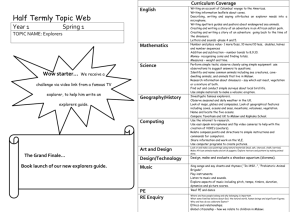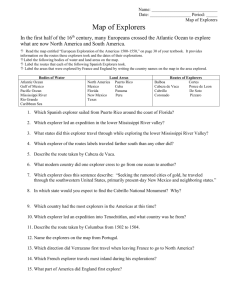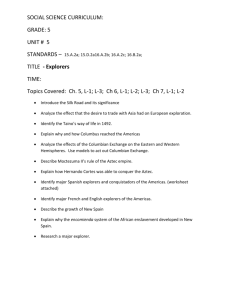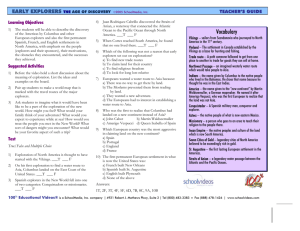SocialStudiesLessonPlan-1
advertisement
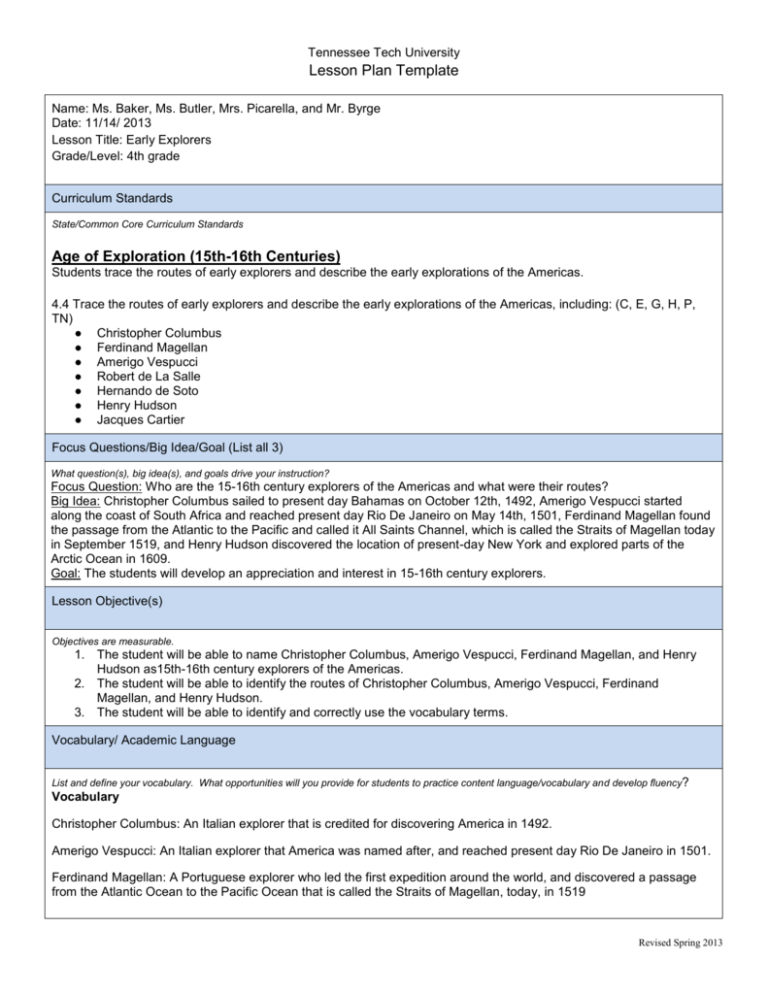
Tennessee Tech University Lesson Plan Template Name: Ms. Baker, Ms. Butler, Mrs. Picarella, and Mr. Byrge Date: 11/14/ 2013 Lesson Title: Early Explorers Grade/Level: 4th grade Curriculum Standards State/Common Core Curriculum Standards Age of Exploration (15th-16th Centuries) Students trace the routes of early explorers and describe the early explorations of the Americas. 4.4 Trace the routes of early explorers and describe the early explorations of the Americas, including: (C, E, G, H, P, TN) ● Christopher Columbus ● Ferdinand Magellan ● Amerigo Vespucci ● Robert de La Salle ● Hernando de Soto ● Henry Hudson ● Jacques Cartier Focus Questions/Big Idea/Goal (List all 3) What question(s), big idea(s), and goals drive your instruction? Focus Question: Who are the 15-16th century explorers of the Americas and what were their routes? Big Idea: Christopher Columbus sailed to present day Bahamas on October 12th, 1492, Amerigo Vespucci started along the coast of South Africa and reached present day Rio De Janeiro on May 14th, 1501, Ferdinand Magellan found the passage from the Atlantic to the Pacific and called it All Saints Channel, which is called the Straits of Magellan today in September 1519, and Henry Hudson discovered the location of present-day New York and explored parts of the Arctic Ocean in 1609. Goal: The students will develop an appreciation and interest in 15-16th century explorers. Lesson Objective(s) Objectives are measurable. 1. The student will be able to name Christopher Columbus, Amerigo Vespucci, Ferdinand Magellan, and Henry Hudson as15th-16th century explorers of the Americas. 2. The student will be able to identify the routes of Christopher Columbus, Amerigo Vespucci, Ferdinand Magellan, and Henry Hudson. 3. The student will be able to identify and correctly use the vocabulary terms. Vocabulary/ Academic Language List and define your vocabulary. What opportunities will you provide for students to practice content language/vocabulary and develop fluency? Vocabulary Christopher Columbus: An Italian explorer that is credited for discovering America in 1492. Amerigo Vespucci: An Italian explorer that America was named after, and reached present day Rio De Janeiro in 1501. Ferdinand Magellan: A Portuguese explorer who led the first expedition around the world, and discovered a passage from the Atlantic Ocean to the Pacific Ocean that is called the Straits of Magellan, today, in 1519 Revised Spring 2013 Henry Hudson: An English explorer that is credited for discovering the location of present day New York in 1609. Academic Language Exploration: The act or an instance of exploring Explorer: A person who travels in search of new geographical or scientific information. Route: An established, selected, or assigned course of travel. Century: A period of 100 years. Students will work with the vocabulary terms when completing the graphic organizer and shape quilt. The students will be exposed to the academic language when listening to the book and the toontastic video Material/Resources What do you need for this lesson? Ipad app Toontastic Plastic bottles White paper Pictures and text of each explorer Glue Crayons, colored pencils, and/or markers So You Want to Be An Explorer? So You Want to be an Explorer Graphic Organizer Classroom Map World Map per student Assessment/Evaluation Formative: How will students demonstrate understanding of lesson objective(s)? How will you monitor and/or give feedback? During the motivation phase, the teacher will ask questions regarding the explorers. These questions will be in regards to the information provided by the toontastic animation and the So You Want to Be An Explorer? Following these activities, the students will be asked to gather into what is known as an ‘agreement circle’. An agreement circle is when the students are gathered into a circle around the room and asked questions regarding the topic, moving ‘in’ or ‘out’ depending on if they agree or disagree. They will also be asked to explain why they agree or disagree. This will allow the teacher to get an understanding on how well the students are grasping the content. As the students are working on their bottle and map projects, the teacher will move around the room assisting and answering any questions as needed. The teacher will examine the students work as they go, and see if they can spot any errors in the work. Summative: What evidence will you collect and how will it document student learning/mastery of lesson objective(s) By the end of the lesson, the students will be expected to craft a shape quilt message in a bottle and a map of the explorers journey. They will be given 20 minutes to gather into groups and work on this. Afterwhich, the students will as groups discuss the explorer they worked on. They will show their bottles and maps, tell the explorers name, what he did and what route he took. When this is finished, the students will put their maps into their bottles and turn both in. Instruction (Include a suggested time for each major activity) List Questions for higher order thinking These cannot be answered by yes or no. (Identify Bloom’s Level of Thinking) Total Time: 60 minutes Set/Motivator: How will you engage student interest in the content of the lesson? Use knowledge of students’ academic, social, and cultural characteristics. Agreement Circle (part two) 10 minutes The teacher will ask the students to form into a circle around the classroom. They will be asked a series of questions regarding the topic of the four explorers (five) and depending on their answer, may step forward in agreement or may step back in disagreement. At one point, the teacher may switch around what is ‘agreement’ and what is ‘disagreement’ to keep the students paying attention. After they’ve chosen their answers, the teacher will pick several students and ask them why they Revised Spring 2013 agreed/disagreed. To which the teacher will explain if they were correct or not correct. 1. Amerigo Vespucci was credited with discovering America (Disagree/False). 2. Ferdinand Magellan led the first expedition around the world (Agree/True) 3. Henry Hudson discovered the city of New York (trick question, Disagree/False). 4. Amerigo Vespucci is the explorer who American is named after. (Agree/True) 5. Ferdinand Magellan discovered a passage between discovered a passage from the Atlantic Ocean to the Pacific Ocean. (Agree/True) Instructional Procedures/Learning Tasks: Provide specific resources/details of lesson content and delivery. To Be An Explorer 15 minutes - The teacher will begin the lesson by passing out the graphic organizer (located at the end of the lesson), and reading So You Want to Be An Explorer? While the teacher is reading the book, the students will listen to the book and fill out the graphic organizer. In order to complete the graphic organizer, the students will have to list character traits, the date of exploration, and the exploration route for each explorer on the organizer. After the teacher has read the book, and the students have completed the organizer, the teacher will lead the class in a discussion about each of the explorers. The class will discuss each explorers' character traits and locate the routes on a class map. The teacher will call on a student to come up to the map and trace the route. Then, the teacher will pass out a world map to each student and have them trace the routes of the explorers on their map, having a different color route for each explorer and making a map key to name which color goes with which explorer. Toontastic (part one) 10 minutes The explorers Christopher Columbus, Amerigo Vespucci, Ferdinand Magellan, and Henry Hudson will be introduced through the ipad app Toontastic. The teacher will use this app to give information about their voyages. Following the video the teacher will elicit responses from the students concerning information provided in the Toontastic video. Shape Quilt (part three) 20 minutes The students will create a shape quilt, a message in a bottle, about one of the explorers explained in the lesson.The students will be broken into groups of 3-4 members. The students will first create a map displaying the route the explorer of their choice traveled. They will use white paper and crayons, colored pencils or markers. The students will then glue pictures and text that describes their explore to the outside of their plastic bottle. Closure: Verbalize or demonstrate learning or skill one more time. May state future learning. Bottle Message 10 minutes The groups will share their “message in a bottle” activities with the class. They will show their bottles and maps, tell the explorers name, what he did and what route he took. The finished map, with this information on it, will be placed into the finished bottle creating the message in a bottle after the discussion. Remember: What does an explorer do? Remember: What qualities must an explorer have? Why are those qualities important? Evaluate: Now that you know the character traits of these explorers, which explorer would you want to meet, and why? Evaluate: Should Christopher Columbus have been credited for finding America when he only found the Bahamas? Why or why not? Analyze: Is it feasible that Travel in the story traveled with all of the explorers? Why or Why not? Understand: How, when, and why did each explorer take their voyage to North America? Evaluate: How can you compare and contrast the 15th and 16th century explorers to explorers of today? Analysis: What influences would have been made on our life today if the explorers had never discovered North America Revised Spring 2013 Adaptations to Meet Individual Needs: How will you adapt the instruction to meet the needs of individual students? Include ELL?; SPED?; Gardner’s Learning Styles - Name and specify what happens in the lesson that uses each learning style listed; Other individual needs of the students/class you are teaching? Gardner’s Learning Styles This lesson specifically addresses these aspects of Gardner’s Learning Styles: Visual-Spacial: Students will be able to investigate the routes of the explorers and to recreate these routes in the bottle activity. Bodily-Kinesthetic: Students will participate in an assessment activity which instructs them to move about the classroom. Agreement circle and creation of Explorer bottle Interpersonal: Students will share information related to their “message in a bottle” craft and communicate to their peers important information about an explorer. Linguistic: Students will listen while the teacher reads a book about the characteristics of an explorer and participate in a discussion about these characteristics. Also listen to Toontastic video. Logical-Mathematical: Using the scale on a map, the students will be able to estimate the number of miles traveled by each explorer. Management/Safety Issues: Are there any management and/or safety issues that need to be considered when teaching this lesson? The students should be reminded that the iPads are a fragile and expensive piece of equipment that has been made available for their use and these tools should be handled with care. Also, students should be monitored while using scissors. Rationale/Theoretical Reasoning: Rationale/ Misconceptions: Many students believe that Christopher Columbus discovered America, but he actually discovered the present day Bahamas. Since many students believe that Christopher Columbus discovered America, they do not associate any of the other early explorers as discovering parts of the Americas as well. Also, students believe that Christopher Columbus went out on a voyage to prove that the earth was round, but he actually set out to explore Asia. Multiple Intelligences: The lesson specifically addresses visual, kinesthetic, interpersonal, intrapersonal, linguistic, and logical-mathematical intelligences in order to help students with varied learning styles to develop knowledge about 15th and 16th century explorers, the routes these explorers traveled and the experiences of these explorers. How this lesson incorporates these theories is discussed in the “adaptations to Meet Individual Needs” section of this lesson plan. Gardner, H. (2000), Intelligence reframed: Multiple intelligence for the 21st century. New York: Basic Books Vygotsky: This lesson incorporates Lev Vygotsky’s Sociocultural Theory by having the students discuss their ideas and findings with the class. Vygotsky, L.S. (1978). Mind in society. The development of higher psychological processes. Cambridge, MA: Harvard University Press. Bloom’s: The teacher is emphasizing Benjamin Bloom's Taxonomy by asking questions that require students to develop higherorder thinking. The questions prompt students to remember, understand, apply, analyze, evaluate, and create. These questions cannot be answered by “yes” or “no”, which allows for higher level thinking. From these questions, students will gain a greater understanding of 15th and 16th century explorers and the motivations for these journeys. Marzano’s Nine Instructional Strategies: Of the Nine Instructional Strategies we employ: Revised Spring 2013 Summarizing and Note Taking (the graphic organizers and handmade map), Homework and Practice (mainly practice via the map making), Nonlinguistic Representations (toontastic, the So You Want to Be An Explorer? book, the maps provided within the classroom), Setting Objectives and Providing Feedback (the entire lesson revolves around identifying the explorers and their routes) and finally Cues, Questions, and Advance Organizers (Bloom Taxonomy, the graphic organizer, agreement circle). http://www.ntuaft.com/TISE/ResearchBased%20Instructional%20Strategies/marzanos%209%20strategies.pdf Bruner: The lesson runs through all three of Bruner’s Modes of Representation. Enactive, which is achieved through making the bottle shape quilt. The movements of the agreement circle and it’s solidifying of information and understanding of the students may also qualify. Iconic, which is achieved through the So You Want to Be An Explorer? book, the toontastic app, the maps provided. Symbolic, which is achieved through the map in the bottle decorated with text and pictures of the explorer the student is focusing on. http://www.simplypsychology.org/bruner.html References: List the references used in this lesson Misconceptions: http://www.livescience.com/16468-christopher-columbus-myths-flat-earth-discovered-americas.html Vocabulary Definitions: http://www.wordcentral.com/home.html Bloom Taxonomy: http://www.odu.edu/educ/roverbau/Bloom/blooms_taxonomy.htm Marzano’s Nine Instructional Strategies: http://www.ntuaft.com/TISE/Research-Based%20Instructional%20Strategies/marzanos%209%20strategies.pdf Brunner: http://www.simplypsychology.org/bruner.html Reflections/Future Modifications: To what extent did the class learn what you intended them to learn? What will be your next steps instructionally? What did you learn about your students as learners? What have you learned about yourself as a teacher? Revised Spring 2013 Revised Spring 2013 Revised Spring 2013
